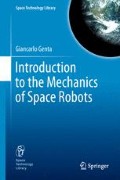Abstract
The variety of configurations for vehicles and moving robots not based on wheeled locomotion that have been suggested for the exploration of planets with a solid surface is so wide that it is impossible to deal with, or even just to mention, them all. Since the most common are those based on some form of legs, the present section is mainly devoted to walking machines. Apart from legged vehicles, only a few other approaches will be briefly described: wheels–legs hybrids, track–leg hybrids, jumping devices, vehicles on skis and apodal devices.
Access this chapter
Tax calculation will be finalised at checkout
Purchases are for personal use only
Notes
- 1.
See for example M.E. Roseheim, Robot Evolution: The Development of Anthrorobotic, Wiley, New York, 1994; F. Junko, Enchanting Gadgets and Engaging Contraptions. Japanese Mechanical Dolls, The East, Vol. VIII, No. 4, April 1972; C. Singer, E.J. Holmyard, A.R. Hall (editors), A History of Technology, Clarendon Press, Oxford, 1954.
- 2.
S.M. Song, K.J. Waldron, Machines that Walk: The Adaptive Suspension Vehicle, MIT Press, Cambridge, 1989.
- 3.
J. Peabody, H.B. Gurocak, Design of a Robot that Walks in Any Direction, Journal of Robotic System, pp. 75–83, 1998.
- 4.
G. Genta, M. Chiaberge, N. Amati, Non Zoomorphic Rigid Frame Walking Micro-Rover for Uneven Ground: From a Demonstrator to an Engineering Prototype, International Conference on Smart Technology Demonstrators & Devices, Edimbourgh, Dec. 2001.
- 5.
D.J. Todd, Walking Machines: An Introduction to Legged Robots, Kogan Page Ltd., London, 1985.
- 6.
M.E. Roseheim, Robot Evolution: The Development of Anthrorobotic, Wiley, New York, 1994.
- 7.
L. Bussolino, D. Del Corso, G. Genta, M.A. Perino, R. Somma, ALGEN—A Walking Robotic Rover for Planetary Exploration, Int. Conf. on Mobile Planetary Robots & Rover Roundup, Santa Monica, 1997; N. Amati, M. Chiaberge, G. Genta, E. Miranda, L.M. Reyneri, Twin Rigid-Frames Walking Microrovers: A Perspective for Miniaturization, Journal of the British Interplanetary Society, Vol. 52, No. 7/8, pp. 301–304, 1999; N. Amati, M. Chiaberge, G. Genta, E. Miranda, L.M. Reyneri, WALKIE 6—A Walking Demonstrator for Planetary Exploration, Space Forum, Vol. 5, No. 4, pp. 259–277, 2000.
- 8.
G. Genta, N. Amati, L.M. Reyneri, Three Rigid Frames Walking Planetary Rovers: A New Concept, 50th Int. Astronautical Congress, Amsterdam, Oct. 1999.
- 9.
G. Genta, N. Amati, Planar Motion Hexapod Walking Machines: A New Configuration, CLAWAR 2001, Professional Engineering Publishing, London, October 2001.
- 10.
For a detailed analysis of the static equilibrium of walking machines, see for instance S.M. Song, K.J. Waldron, Machines that Walk: The Adaptive Suspension Vehicle, MIT Press, Cambridge, 1989.
- 11.
Birds are not considered here: for them walking is only a secondary form of locomotion, they can anyway use their wings to produce aerodynamic forces that help to maintain equilibrium, and above all their body is extended in horizontal direction and not vertical, yielding a low position of the center of mass.
- 12.
G. Genta, Simplified Model of a Small Planetary Roverw with Active Suspensions, VII IAA Symposium on Near Term Advanced Space Missions, Aosta, July 2011.
- 13.
Here with hopping robots are intended robots that are propelled by forces exerted against the surface, and not jet (or rocket) propelled robots. Also robots propelled by inertia forces due to unbalanced rotors are not dealt with.
Author information
Authors and Affiliations
Corresponding author
Rights and permissions
Copyright information
© 2012 Springer Science+Business Media B.V.
About this chapter
Cite this chapter
Genta, G. (2012). Non-wheeled Vehicles and Rovers. In: Introduction to the Mechanics of Space Robots. Space Technology Library, vol 26. Springer, Dordrecht. https://doi.org/10.1007/978-94-007-1796-1_6
Download citation
DOI: https://doi.org/10.1007/978-94-007-1796-1_6
Publisher Name: Springer, Dordrecht
Print ISBN: 978-94-007-1795-4
Online ISBN: 978-94-007-1796-1
eBook Packages: EngineeringEngineering (R0)

